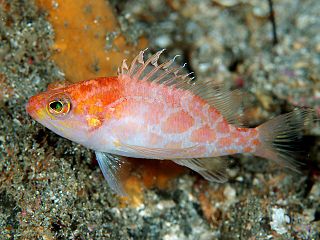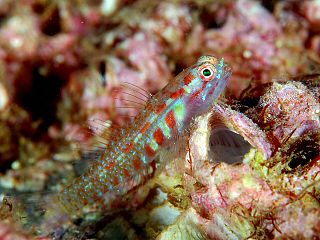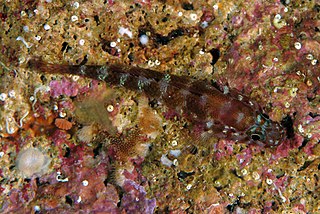
Gobiidae is a family of bony fish in the order Gobiiformes, one of the largest fish families comprising more than 2,000 species in more than 200 genera, sometimes referred to as the "true gobies". Most of them are relatively small, typically less than 10 cm (3.9 in) in length. The Gobiidae includes some of the smallest vertebrates in the world, such as Trimmatom nanus and Pandaka pygmaea, Trimmatom nanus are under 1 cm long when fully grown, then Pandaka pygmaea standard length are 9mm (0.35 in),maximum known standard length are 11 mm (0.43 in). Some large gobies can reach over 30 cm (0.98 ft) in length, but that is exceptional. Generally, they are benthic, or bottom-dwellers. Although few are important as food for humans, they are of great significance as prey species for commercially important fish such as cod, haddock, sea bass, and flatfish. Several gobiids are also of interest as aquarium fish, such as the dartfish of the genus Ptereleotris. Phylogenetic relationships of gobiids have been studied using molecular data.

Eleotridae is a family of fish commonly known as sleeper gobies, with about 34 genera and 180 species. Most species are found in the tropical Indo-Pacific region, but there are also species in subtropical and temperate regions, warmer parts of the Americas and near the Atlantic coast in Africa. While many eleotrids pass through a planktonic stage in the sea and some spend their entire lives in the sea; as adults, the majority live in freshwater streams and brackish water. One of its genera, Caecieleotris, is troglobitic. They are especially important as predators in the freshwater stream ecosystems on oceanic islands such as New Zealand and Hawaii that otherwise lack the predatory fish families typical of nearby continents, such as catfish. Anatomically, they are similar to the gobies (Gobiidae), though unlike the majority of gobies, they do not have a pelvic sucker.
Collared wrigglers are perciform fishes in the family Xenisthmidae. They are native to the Indian and Pacific Oceans, where they are mostly reef-dwelling.

Gobiodon is a genus of gobies also known as coral gobies or "clown gobies". Generally, coral gobies, unlike the rest of the family Gobiidae, are not burrowers, but instead prefer to inhabit the branches of certain Acropora or similar hard corals.

Plectranthias is a genus of ray-finned fish in the subfamily Anthiinae, part of the family Serranidae, the groupers and sea basses. They are found in the Atlantic, Indian and Pacific Ocean.
Pascua is a genus of gobies native to the Pacific Ocean. The origin of the name "Pascua" is from the Spanish for "Easter" in recognition of the Easter Island range of the type specimen.

Eviota is a genus of fish in the family Gobiidae, commonly as dwarfgobies found in the Indo-Pacific region, where it is distributed from Japan to Australia and from Africa to Pitcairn Island. Species are mainly associated with coral reefs. Many of these fish are short-lived, with life cycles as brief as 3.5 weeks in the tropics. Some species are hermaphrodites and some representatives live symbiotically among the tentacles of the mushroom coral.

Glossogobius is a genus of gobies native to fresh, brackish and marine waters from Africa to the coasts of the western Pacific Ocean. They are found in Madagascar, South Africa, Japan, Thailand, Australia, Indonesia, Bangladesh, the Philippines, Taiwan, Papua New Guinea, Singapore, Malawi, Swaziland, Botswana, Kenya, Zimbabwe, Tanzania, Mozambique, the Solomon Islands, Palau, Fiji, New Caledonia, India, Laos, Sri Lanka, Myanmar, Borneo, Nepal, Brunei Darussalam, Micronesia, Cambodia, Viet Nam, China, Réunion, the Seychelles, Mauritius, the Caroline Islands, Vanuatu, Malaysia and Russia. The genus also includes a troglobitic species, G. ankaranensis.

Gobius is a genus of fish in the family Gobiidae native to fresh, brackish and marine waters of and around Europe, Africa and Asia. It contains the typical gobies, being the type genus of the formerly recognised subfamily Gobiinae and family and the namesake genus of its order Gobiiformes.

Priolepis is a genus of fish in the family Gobiidae with a cosmopolitan distribution.

The Gobiiformes are an order of fish that includes the gobies and their relatives. The order, which was previously considered a suborder of Perciformes, is made up of about 2,211 species that are divided between seven families. Phylogenetic relationships of the Gobiiformes have been elucidated using molecular data. Gobiiforms are primarily small species that live in marine water, but roughly 10% of these species inhabit fresh water. This order is composed chiefly of benthic or burrowing species; like many other benthic fishes, most gobiiforms do not have a gas bladder or any other means of controlling their buoyancy in water, so they must spend most of their time on or near the bottom. Gobiiformes means "Goby-like".

Tomiyamichthys is a genus of gobies found from the Red Sea through the Indian Ocean to the western Pacific Ocean. The name of this genus honours the Japanese ichthyologist Itiro Tomiyama of the Tokyo Imperial University, who described the type species, Tomiyamichthys oni, in 1936.

Didogobius is a genus of small marine fish in the family Gobiidae, the true gobies. They are native to the eastern Atlantic Ocean and the Mediterranean Sea. The name of the genus is a compound noun made up of Dido, the mythical founder and first queen of Carthage, and the Latin gobius meaning "goby".

Steinitz's goby is a species of goby. It is native to the Mediterranean Sea near Marseilles. Recently recorded in the Adriatic Sea in Croatia, Tyrrhenian Sea in Italy, and in the Black Sea in Ukraine. This species can be found in underwater grottoes in inshore waters at depths of from 2 to 15 metres. It can reach a length of 3.8 centimetres (1.5 in) SL. The specific name honours the marine biologist and herpetologist Heinz Steinitz (1909-1971) of the Hebrew University, Jerusalem.
Pseudamiops is a genus of cardinalfishes native to the Pacific and Indian oceans.

Cabillus is a genus of gobies native to the Indian and Pacific oceans.

Callogobius is a genus of fish in the family Gobiidae found in brackish and marine waters of the Indian and Pacific Ocean.
Coryogalops is a genus of gobies native to the southeastern Atlantic Ocean and the western Indian Ocean along the coasts of Africa and Asia from South Africa to Pakistan.

Pleurosicya is a genus of gobies native to reef environments of the Indian Ocean and the western Pacific Ocean.

Trimma is a genus of fish in the family Gobiidae native to the Indian and Pacific Ocean. Together with members of the genus Eviota, they are known commonly as pygmygobies or dwarfgobies.















